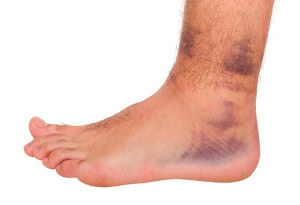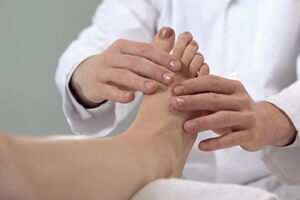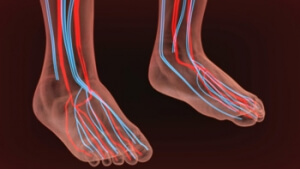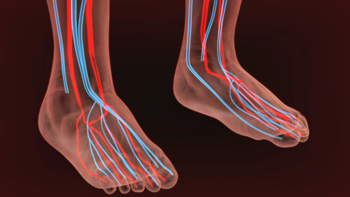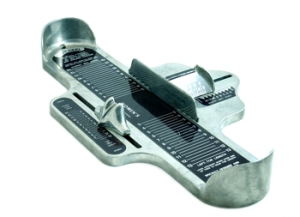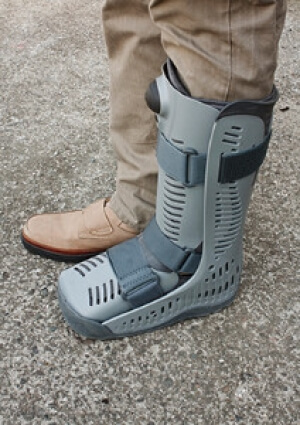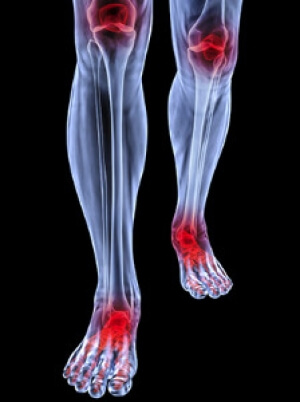Connect With Us
Super User
Strengthening the Ankle After a Sprain
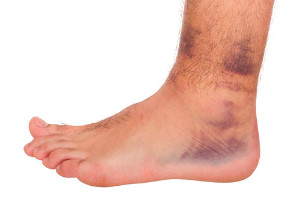 If you should endure an injury that tears the ligaments in the ankle, you may have what is known as an ankle sprain. A common symptom that is associated with this condition is severe pain while attempting to walk on the affected ankle. Additionally, the ankle can appear bruised and swollen. Research has indicated it is beneficial to start treatment as quickly as possible after the injury has occurred. This consists of resting the foot while elevating it above heart level, and wrapping the ankle with an elastic bandage. It may be necessary to strengthen the ankle before returning to any type of sporting activity. These exercises include toe raises, resistance movements, and balancing motions. If you have sprained your ankle, it is advised that you seek the counsel of a podiatrist who can guide you toward the correct treatment.
If you should endure an injury that tears the ligaments in the ankle, you may have what is known as an ankle sprain. A common symptom that is associated with this condition is severe pain while attempting to walk on the affected ankle. Additionally, the ankle can appear bruised and swollen. Research has indicated it is beneficial to start treatment as quickly as possible after the injury has occurred. This consists of resting the foot while elevating it above heart level, and wrapping the ankle with an elastic bandage. It may be necessary to strengthen the ankle before returning to any type of sporting activity. These exercises include toe raises, resistance movements, and balancing motions. If you have sprained your ankle, it is advised that you seek the counsel of a podiatrist who can guide you toward the correct treatment.
Although ankle sprains are common, they aren’t always minor injuries. If you need your ankle injury looked at, contact one of our podiatrists from New Jersey Foot & Ankle Centers. Our doctors can provide the care you need to keep you pain-free and on your feet.
How Does an Ankle Sprain Occur?
Ankle sprains are the result of a tear in the ligaments within the ankle. These injuries may happen when you make a rapid shifting movement while your foot is planted. A less common way to sprain your ankle is when your ankle rolls inward while your foot turns outward.
What Are the Symptoms?
- Pain at the sight of the tear
- Bruising/Swelling
- Ankle area is tender to touch
- In severe cases, may hear/feel something tear
- Skin discoloration
Preventing a Sprain
- Wearing appropriate shoes for the occasion
- Stretching before exercises and sports
- Knowing your limits
Treatment of a Sprain
In many cases, the RICE method (Rest, Ice, Compression, and Elevate) is used to treat ankle sprains. However, you should see a podiatrist to see which treatment option would work best with your injury. In severe cases, surgery may be required.
It is important to ask your doctor about rehab options after you receive treatment for your injury. Stretching, strength training, and balance exercises may help the ankle heal while also preventing further injury.
If you have any questions, please feel free to contact our office located in Oradell, NJ . We offer the newest diagnostic and treatment technologies for all your foot care needs.
Foot Stretches to Prevent Injuries
Keeping the feet stretched and limber is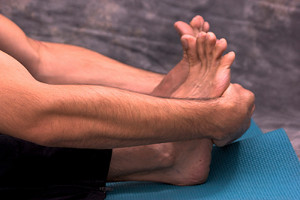 important due to stress that is put on them on a daily basis. Taking a couple minutes each day to stretch out your feet can help prevent foot injuries. There are five simple stretches to help you do this. The first exercise is a towel stretch. Sit on the floor with your legs right in front of you and place a towel around your toes. Then slowly pull the towel towards you. Hold for 15 to 30 seconds each time and do three sets of these. The next exercise is towel lifts. For this one, you will sit in a chair and place a towel on the floor. The point of this exercise is to try lifting the towel off the ground with just your toes. Do this five times on each foot. The third stretch is called the step stretch. This involves standing with your toes on a step with your heels hanging off the edge. Slowly lower your heels down, hold for 10 to 15 seconds and then lift your heels back to the starting position. This should be repeated 5 to 10 times. The fourth stretch is the toe stretch and the most basic one of them all. For this exercise, you will sit in a chair with your feet on the floor and toes spread apart. This position should be held for a few seconds and then repeated 10 times. The final exercise is called the foot roll. This entails taking a golf ball, and rolling it back from your toes to your heels. A tennis ball is also frequently used. Doing these five stretches just for a bit each day will help to prevent injuries in the long run.
important due to stress that is put on them on a daily basis. Taking a couple minutes each day to stretch out your feet can help prevent foot injuries. There are five simple stretches to help you do this. The first exercise is a towel stretch. Sit on the floor with your legs right in front of you and place a towel around your toes. Then slowly pull the towel towards you. Hold for 15 to 30 seconds each time and do three sets of these. The next exercise is towel lifts. For this one, you will sit in a chair and place a towel on the floor. The point of this exercise is to try lifting the towel off the ground with just your toes. Do this five times on each foot. The third stretch is called the step stretch. This involves standing with your toes on a step with your heels hanging off the edge. Slowly lower your heels down, hold for 10 to 15 seconds and then lift your heels back to the starting position. This should be repeated 5 to 10 times. The fourth stretch is the toe stretch and the most basic one of them all. For this exercise, you will sit in a chair with your feet on the floor and toes spread apart. This position should be held for a few seconds and then repeated 10 times. The final exercise is called the foot roll. This entails taking a golf ball, and rolling it back from your toes to your heels. A tennis ball is also frequently used. Doing these five stretches just for a bit each day will help to prevent injuries in the long run.
Why Stretching Is Important for Your Feet
Stretching the feet is a great way to prevent injuries. If you have any concerns with your feet consult with one of our podiatrists from New Jersey Foot & Ankle Centers. Our doctors will assess your condition and provide you with quality foot and ankle treatment.
Stretching the Feet
Stretching the muscles in the foot is an important part in any physical activity. Feet that are tight can lead to less flexibility and make you more prone to injury. One of the most common forms of foot pain, plantar fasciitis, can be stretched out to help ease the pain. Stretching can not only ease pain from plantar fasciitis but also prevent it as well. However, it is important to see a podiatrist first to determine if stretching is right for you. Podiatrists can also recommend other ways to stretch your feet. Once you know whether stretching is right for you, here are some excellent stretches you can do.
- Using a foam roller or any cylindrical object (a water bottle or soda can will do), roll the object under your foot back and forth. You should also exert pressure on the object. Be sure to do this to both feet for a minute. Do this exercise three times each.
- Similar to the previous exercise, take a ball, such as a tennis ball, and roll it under your foot while seated and exert pressure on it.
- Grab a resistance band or towel and take a seat. If you are using a towel, fold it length wise. Next put either one between the ball of your foot and heel and pull with both hands on each side towards you. Hold this for 15 seconds and then switch feet. Do this three times for each foot.
- Finally hold your big toe while crossing one leg over the other. Pull the toe towards you and hold for 15 seconds. Once again do this three times per foot.
It is best to go easy when first stretching your foot and work your way up. If your foot starts hurting, stop exercising to ice and rest the foot. It is advised that you then see a podiatrist for help.
If you have any questions, please feel free to contact our office located in Oradell, NJ . We offer the newest diagnostic and treatment technologies for all your foot care needs.
What Is Poor Circulation?
Inadequate blood flow in the body is referred to as poor circulation. The symptoms that are associated with this condition often include a tingling or numbing sensation in the feet and hands, the toenails may become brittle and dry, and wounds on the feet may heal slower than usual. If there are some existing medical conditions, it may increase the risk of developing poor circulation. These can include diabetes, elevated blood pressure, and high cholesterol. Research has indicated it may be beneficial to incorporate a gentle exercise program into your daily routine, as this can help to control specific medical conditions. If you are suffering from this ailment, it is suggested that you seek the counsel of a podiatrist who can help you with proper treatment options.
While poor circulation itself isn’t a condition; it is a symptom of another underlying health condition you may have. If you have any concerns with poor circulation in your feet contact one of our podiatrists of New Jersey Foot & Ankle Centers. Our doctors will treat your foot and ankle needs.
Poor Circulation in the Feet
Peripheral artery disease (PAD) can potentially lead to poor circulation in the lower extremities. PAD is a condition that causes the blood vessels and arteries to narrow. In a linked condition called atherosclerosis, the arteries stiffen up due to a buildup of plaque in the arteries and blood vessels. These two conditions can cause a decrease in the amount of blood that flows to your extremities, therefore resulting in pain.
Symptoms
Some of the most common symptoms of poor circulation are:
- Numbness
- Tingling
- Throbbing or stinging pain in limbs
- Pain
- Muscle Cramps
Treatment for poor circulation often depends on the underlying condition that causes it. Methods for treatment may include insulin for diabetes, special exercise programs, surgery for varicose veins, or compression socks for swollen legs.
As always, see a podiatrist as he or she will assist in finding a regimen that suits you. A podiatrist can also prescribe you any needed medication.
If you have any questions, please feel free to contact our office located in Oradell, NJ . We offer the newest diagnostic and treatment technologies for all your foot care needs.
Read more about Causes Symptoms and Treatment for Poor Circulation in the FeetMethods on How to Properly Measure Feet
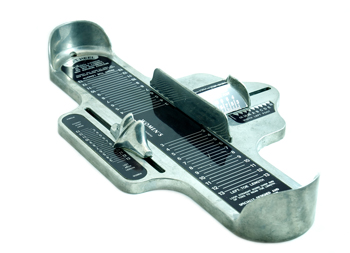 When shoes fit properly, the feet will generally feel good. This being stated, research has indicated that many people wear shoes that are the wrong size, and can cause foot conditions to develop which may include bunions and hammertoes. Many people choose to purchase shoes that are slightly tight, and they often think the shoes will gradually stretch to accommodate their foot. It is important to properly measure the foot which can help to determine the correct shoe size. This can be accomplished by tracing the foot on a piece of paper, and it is helpful to wear the socks that are typically worn with the chosen shoes. At this point, the width and length of the foot can be measured. An alternative would be to use a Brannock device, which is found it many shoe stores. A podiatrist is able to provide you with additional information about how to buy shoes that fit correctly.
When shoes fit properly, the feet will generally feel good. This being stated, research has indicated that many people wear shoes that are the wrong size, and can cause foot conditions to develop which may include bunions and hammertoes. Many people choose to purchase shoes that are slightly tight, and they often think the shoes will gradually stretch to accommodate their foot. It is important to properly measure the foot which can help to determine the correct shoe size. This can be accomplished by tracing the foot on a piece of paper, and it is helpful to wear the socks that are typically worn with the chosen shoes. At this point, the width and length of the foot can be measured. An alternative would be to use a Brannock device, which is found it many shoe stores. A podiatrist is able to provide you with additional information about how to buy shoes that fit correctly.
Finding a properly-fitting shoe is important in reducing injuries and preventing foot problems. For more information about treatment, contact one of our podiatrists from New Jersey Foot & Ankle Centers. Our doctors will treat your foot and ankle needs.
Proper Shoe Fitting
A common concern when it comes to foot health, having properly fitted shoes can help prevent injuries to the foot. Out feet affect our posture and gait, which in turn affects the biomechanics and overall bodily structure. With 33 joints, 26 bones, and over 100 ligaments, the potential for serious injury is much greater than one realizes. Although the feet cease growth in adulthood, they still change shape as they mature. Here are some factors to consider when it comes to investing in proper fitting shoes:
- Be sure the shoes fit correctly right away
- Ensure the ball of your foot fits comfortably in the widest portion of the shoes
- Even though they may look fashionable, improper fitting shoes can either create adverse conditions or exacerbate existing ones you may already have
- Walk along a carpeted surface to ensure the shoes comfortably fit during normal activity
Keeping in mind how shoes fit the biomechanics of your body, properly-fitting shoes are vitally important. Fortunately, it is not difficult to acquire footwear that fits correctly. Be sure to wear shoes that support the overall structure of your body. Do your feet a favor and invest in several pairs of well-fitted shoes today.
If you have any questions please feel free to contact our office located in Oradell, NJ . We offer the newest diagnostic and treatment technologies for all your foot and ankle needs.
Read more about How to Get a Proper Shoe FitA Broken Foot May Be Common in Children
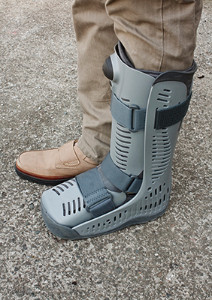 A broken foot can be a common ailment that may occur in children. This can be a result of the bones in the feet that have not fully developed and are more fragile than the bones in the adult foot. If a broken foot occurs, noticeable symptoms often include severe pain, redness, swelling, and it may be difficult to walk on. Your child may find moderate relief when the affected foot is elevated, and a splint may temporarily be applied that can provide the necessary support. After a proper diagnosis is performed, which generally consists of having and X-ray taken, a cast or a protective boot is worn that can limit excess movement as the healing process takes place. If your child has fallen, and complains of foot pain, it is suggested that you consult with a podiatrist who can properly treat a broken foot.
A broken foot can be a common ailment that may occur in children. This can be a result of the bones in the feet that have not fully developed and are more fragile than the bones in the adult foot. If a broken foot occurs, noticeable symptoms often include severe pain, redness, swelling, and it may be difficult to walk on. Your child may find moderate relief when the affected foot is elevated, and a splint may temporarily be applied that can provide the necessary support. After a proper diagnosis is performed, which generally consists of having and X-ray taken, a cast or a protective boot is worn that can limit excess movement as the healing process takes place. If your child has fallen, and complains of foot pain, it is suggested that you consult with a podiatrist who can properly treat a broken foot.
A broken foot requires immediate medical attention and treatment. If you need your feet checked, contact one of our podiatrists from New Jersey Foot & Ankle Centers. Our doctors can provide the care you need to keep you pain-free and on your feet.
Broken Foot Causes, Symptoms, and Treatment
A broken foot is caused by one of the bones in the foot typically breaking when bended, crushed, or stretched beyond its natural capabilities. Usually the location of the fracture indicates how the break occurred, whether it was through an object, fall, or any other type of injury.
Common Symptoms of Broken Feet:
- Bruising
- Pain
- Redness
- Swelling
- Blue in color
- Numbness
- Cold
- Misshapen
- Cuts
- Deformities
Those that suspect they have a broken foot shoot seek urgent medical attention where a medical professional could diagnose the severity.
Treatment for broken bones varies depending on the cause, severity and location. Some will require the use of splints, casts or crutches while others could even involve surgery to repair the broken bones. Personal care includes the use of ice and keeping the foot stabilized and elevated.
If you have any questions please feel free to contact our office located in Oradell, NJ . We offer the newest diagnostic and treatment technologies for all your foot and ankle needs.
Additional Body Fluid May Cause Edema
 Many women often notice their feet and ankles are swollen during their pregnancies. This can be a result of thicker blood, and fifty percent additional body fluid throughout the pregnancy. The feet and ankles may often feel the brunt of the swelling, which can be due to pressure the fetus exerts on the pelvis. This can cause poor circulation in the feet, and swelling, which is also known as edema. There are methods that can be taken which may alleviate a portion of the swelling. These can consist of elevating your feet as often as possible, wearing shoes and socks that fit loosely, and drinking plenty of water daily. If you would like additional information about how to minimize swelling in the lower extremities, it is suggested that you consult with a podiatrist.
Many women often notice their feet and ankles are swollen during their pregnancies. This can be a result of thicker blood, and fifty percent additional body fluid throughout the pregnancy. The feet and ankles may often feel the brunt of the swelling, which can be due to pressure the fetus exerts on the pelvis. This can cause poor circulation in the feet, and swelling, which is also known as edema. There are methods that can be taken which may alleviate a portion of the swelling. These can consist of elevating your feet as often as possible, wearing shoes and socks that fit loosely, and drinking plenty of water daily. If you would like additional information about how to minimize swelling in the lower extremities, it is suggested that you consult with a podiatrist.
Pregnant women with swollen feet can be treated with a variety of different methods that are readily available. For more information about other cures for swollen feet during pregnancy, consult with one of our podiatrists from New Jersey Foot & Ankle Centers. Our doctors will attend to all of your foot and ankle needs.
What Foot Problems Can Arise During Pregnancy?
One problem that can occur is overpronation, which occurs when the arch of the foot flattens and tends to roll inward. This can cause pain and discomfort in your heels while you’re walking or even just standing up, trying to support your baby.
Another problem is edema, or swelling in the extremities. This often affects the feet during pregnancy but tends to occur in the later stages.
How Can I Keep My Feet Healthy During Pregnancy?
- Wearing orthotics can provide extra support for the feet and help distribute weight evenly
- Minimize the amount of time spent walking barefoot
- Wear shoes with good arch support
- Wear shoes that allow for good circulation to the feet
- Elevate feet if you experience swelling
- Massage your feet
- Get regular, light exercise, such as walking, to promote blood circulation to the feet
If you have any questions please feel free to contact our office located in Oradell, NJ . We offer the newest diagnostic and treatment technologies for all your foot and ankle needs.
What to Expect When You Have Arthritic Feet
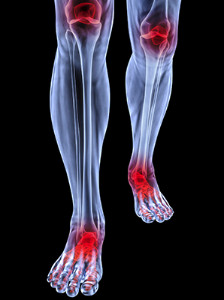 Unfortunately, arthritic feet can lead to a number of foot complications if not properly monitored. Arthritis can be passed down by genetics or through injuries, most commonly affecting athletes as well as industrial workers. Bacterial and viral infections that strike the joints can also lead to arthritis. It’s important you seek professional help when you notice the following symptoms: swelling, redness, limitation of motion, rashes, and pain or tenderness in the joints of the feet. To treat arthritic feet, a podiatrist may prescribe custom orthotics to correct the alignment of the feet and ankles, or in severe cases, may suggest surgery. For more information about arthritic feet, we recommend you consult with a podiatrist for a proper diagnosis and suggested treatment regime.
Unfortunately, arthritic feet can lead to a number of foot complications if not properly monitored. Arthritis can be passed down by genetics or through injuries, most commonly affecting athletes as well as industrial workers. Bacterial and viral infections that strike the joints can also lead to arthritis. It’s important you seek professional help when you notice the following symptoms: swelling, redness, limitation of motion, rashes, and pain or tenderness in the joints of the feet. To treat arthritic feet, a podiatrist may prescribe custom orthotics to correct the alignment of the feet and ankles, or in severe cases, may suggest surgery. For more information about arthritic feet, we recommend you consult with a podiatrist for a proper diagnosis and suggested treatment regime.
Arthritis can be a difficult condition to live with. If you are seeking treatment, contact one of our podiatrists from New Jersey Foot & Ankle Centers. Our doctors can provide the care you need to keep you pain-free and on your feet.
Arthritic Foot Care
Arthritis is a term that is commonly used to describe joint pain. The condition itself can occur to anyone of any age, race, or gender, and there are over 100 types of it. Nevertheless, arthritis is more commonly found in women compared to men, and it is also more prevalent in those who are overweight. The causes of arthritis vary depending on which type of arthritis you have. Osteoarthritis for example, is often caused by injury, while rheumatoid arthritis is caused by a misdirected immune system.
Symptoms
- Swelling
- Pain
- Stiffness
- Decreased Range of Motion
Arthritic symptoms range in severity, and they may come and go. Some symptoms stay the same for several years but could potentially get worse with time. Severe cases of arthritis can prevent its sufferers from performing daily activities and make walking difficult.
Risk Factors
- Occupation – Occupations requiring repetitive knee movements have been linked to osteoarthritis
- Obesity – Excess weight can contribute to osteoarthritis development
- Infection – Microbial agents can infect the joints and trigger arthritis
- Joint Injuries – Damage to joints may lead to osteoarthritis
- Age – Risk increases with age
- Gender –Most types are more common in women
- Genetics – Arthritis can be hereditary
If you suspect your arthritis is affecting your feet, it is crucial that you see a podiatrist immediately. Your doctor will be able to address your specific case and help you decide which treatment method is best for you.
If you have any questions, please feel free to contact our office located in Oradell, NJ . We offer the newest diagnostic and treatment technologies for all your foot care needs.
How to Care for Your Arthritic Foot
Arthritis is an inflammation of the joints and it can occur at any joint in the body, especially in the foot. It generally effects those who are older, however, it can occur at any age. Although there are many different forms of arthritis, there are three main types that occur in the foot. The three types are osteoarthritis, rheumatoid arthritis, and gout.
The primary cause of osteoarthritis is aging. As you age, cartilage degenerates around the joints which causes friction and pain. Obesity can cause osteoarthritis through mechanical stress. Injuries that damage joints can increase the probability as well. Finally, a family history of osteoarthritis can also increase chances of having it.
Rheumatoid arthritis occurs when the immune system attacks the joint linings and weakens them over a long time. While there is no known cause of rheumatoid arthritis, obesity and smoking can increase your chances of getting it. Women are also more likely to get it than men.
Gout is a form of arthritis that occurs when there is too much uric acid in your blood and painful crystals form in your joints. Men are more likely to have gout than women. People who are obese or drink alcohol often are also more likely to develop gout. Furthermore, having diabetes, heart disease, high blood pressure, high cholesterol, gastric bypass surgery or a family history of gout may increase your likelihood of developing the condition.
Symptoms of arthritis include pain, stiffness, swelling in the joints. These symptoms can make it harder and more painful to walk. Physical activity can increase pain and discomfort. Furthermore, joint pain can worsen throughout the day for osteoarthritis. Gout attacks generally last several days with the first few being the worst.
Diagnosis of gout includes either a joint fluid test or a blood test. X-ray imaging can detect osteoarthritis but not gout. On the other hand, there is no blood test for osteoarthritis. Rheumatoid arthritis is difficult to diagnosis. Doctors utilize family and personal medical history, a physical examination, and antibody blood tests to determine if you have rheumatoid arthritis.
Treatment varies for the different kinds of arthritis. Anti-inflammatory medication or steroids can help reduce pain from inflammation of the joints. Changing shoe types can help with some symptoms. Wider shoes can help with discomfort from gout and osteoarthritis. High heels should be avoided. Shoes with proper arch support and that take pressure off the ball of the foot can help with rheumatoid arthritis. Drinking lots of water can also help rid uric acid from the blood. Losing weight, improving your diet, and limiting alcohol and smoking can also help prevent or lessen the symptoms of arthritis.
If you are having trouble walking or pain in your feet, see a podiatrist to check if you have arthritis.
Swollen Feet During Pregnancy
 Foot conditions are generally a common ailment among pregnant women. The weight from increased blood volume, as well as the growing fetus, may cause the feet to become flat, which can produce sharp or aching pains. Moderate relief may be found when shoes that are worn fit properly. To ensure a perfect fit and for extra support, it may help to wear custom-made orthotics. Additionally, swollen feet and ankles are a common ailment among pregnant patients, and can be uncomfortable. It is beneficial to elevate the feet frequently during the day, as this may help to reduce existing swelling. Some pregnant women experience ingrown toenails, which may be a result of changes in the size and shape of the toenail. If you would like more information about how your feet may be affected during pregnancy, it is recommended that you consult with a podiatrist.
Foot conditions are generally a common ailment among pregnant women. The weight from increased blood volume, as well as the growing fetus, may cause the feet to become flat, which can produce sharp or aching pains. Moderate relief may be found when shoes that are worn fit properly. To ensure a perfect fit and for extra support, it may help to wear custom-made orthotics. Additionally, swollen feet and ankles are a common ailment among pregnant patients, and can be uncomfortable. It is beneficial to elevate the feet frequently during the day, as this may help to reduce existing swelling. Some pregnant women experience ingrown toenails, which may be a result of changes in the size and shape of the toenail. If you would like more information about how your feet may be affected during pregnancy, it is recommended that you consult with a podiatrist.
Pregnant women with swollen feet can be treated with a variety of different methods that are readily available. For more information about other cures for swollen feet during pregnancy, consult with one of our podiatrists from New Jersey Foot & Ankle Centers. Our doctors will attend to all of your foot and ankle needs.
What Foot Problems Can Arise During Pregnancy?
One problem that can occur is overpronation, which occurs when the arch of the foot flattens and tends to roll inward. This can cause pain and discomfort in your heels while you’re walking or even just standing up, trying to support your baby.
Another problem is edema, or swelling in the extremities. This often affects the feet during pregnancy but tends to occur in the later stages.
How Can I Keep My Feet Healthy During Pregnancy?
- Wearing orthotics can provide extra support for the feet and help distribute weight evenly
- Minimize the amount of time spent walking barefoot
- Wear shoes with good arch support
- Wear shoes that allow for good circulation to the feet
- Elevate feet if you experience swelling
- Massage your feet
- Get regular, light exercise, such as walking, to promote blood circulation to the feet
If you have any questions please feel free to contact our office located in Oradell, NJ . We offer the newest diagnostic and treatment technologies for all your foot and ankle needs.
How Cracked Heels Develop and How to Treat Them
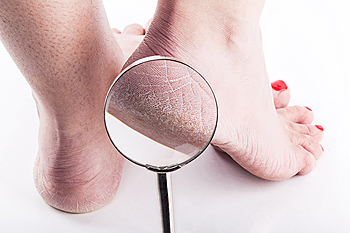 Cracked heels are generally a common condition among those who typically wear open footwear. Besides having a displeasing appearance, cracked heels can also be very uncomfortable and painful for patients who are afflicted with this ailment. Common causes that lead to the development of cracked heels may include standing for the majority of the day, increased pressure on the heels due to obesity, and certain skin conditions such as eczema or athlete’s foot. Along with the pain they may cause, cracked heels that are more severe can also lead to bleeding. It is said one way to help begin the process of healing cracked heels is by drinking plenty of water and remaining hydrated. Applying moisturizers, petroleum jelly, healing cream, and moisturizing socks may also help to reduce the dryness in your heels. Patients have also found soaking their feet, followed by using a pumice stone as an exfoliant, is helpful in treating cracked heels. For more advice on how to best treat cracked heels, please consult with a podiatrist for treatment plans and professional care.
Cracked heels are generally a common condition among those who typically wear open footwear. Besides having a displeasing appearance, cracked heels can also be very uncomfortable and painful for patients who are afflicted with this ailment. Common causes that lead to the development of cracked heels may include standing for the majority of the day, increased pressure on the heels due to obesity, and certain skin conditions such as eczema or athlete’s foot. Along with the pain they may cause, cracked heels that are more severe can also lead to bleeding. It is said one way to help begin the process of healing cracked heels is by drinking plenty of water and remaining hydrated. Applying moisturizers, petroleum jelly, healing cream, and moisturizing socks may also help to reduce the dryness in your heels. Patients have also found soaking their feet, followed by using a pumice stone as an exfoliant, is helpful in treating cracked heels. For more advice on how to best treat cracked heels, please consult with a podiatrist for treatment plans and professional care.
Cracked heels are unsightly and can cause further damage to your shoes and feet. If you have any concerns, contact one of our podiatrists from New Jersey Foot & Ankle Centers. Our doctors can provide the care you need to keep you pain-free and on your feet.
Cracked Heels
Cracked heels appear unappealing and can make it harder for you walk around in sandals. Aside from looking unpleasant, cracked heels can also tear stockings, socks, and wear out your shoes. There are several methods to help restore a cracked heel and prevent further damage.
How Do You Get Them?
Dry skin is the number one culprit in creating cracked heels. Many athletes, walkers, joggers, and even swimmers suffer from cracked heels. Age and skin oil production play a role to getting cracked heels as well.
Promote Healing
Over the counter medicines can help, especially for those that need instant relief or who suffer from chronic dry feet.
Wear Socks – Wearing socks with medicated creams helps lock in moisture.
Moisturizers – Applying both day and night will help alleviate dryness which causes cracking.
Pumice Stones – These exfoliate and remove dead skin, which allows for smoother moisturizer application and better absorption into the skin.
Change in Diet
Eating healthy with a well-balanced diet will give the skin a fresh and radiant look. Your body responds to the kinds of food you ingest. Omega-3 fatty acids and zinc supplements can also revitalize skin tissue.
Most importantly, seek professional help if unsure how to proceed in treating cracked heels. A podiatrist will help you with any questions or information needed.
If you have any questions, please feel free to contact our office located in Oradell, NJ . We offer the newest diagnostic and treatment technologies for all your foot care needs.
